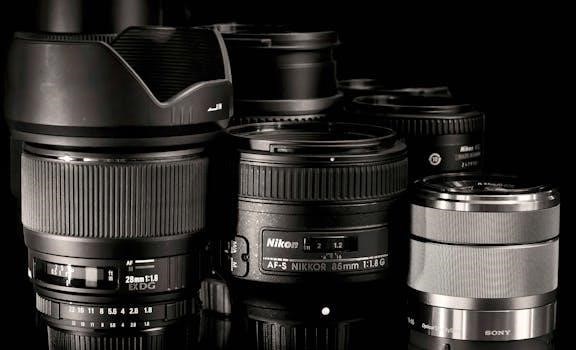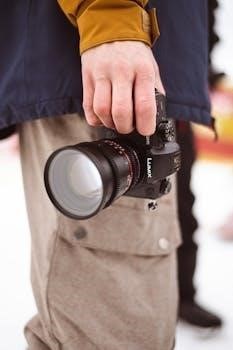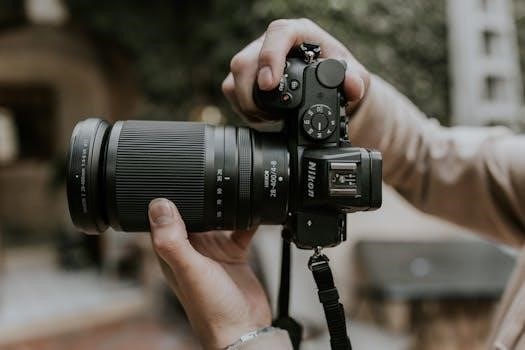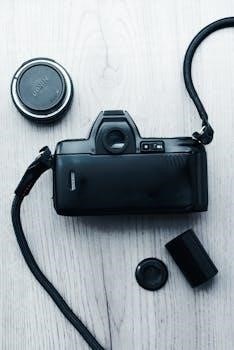nikon speedlight sb 700 manual
Nikon Speedlight SB-700 Manual⁚ An Article Plan
This article provides a comprehensive guide to the Nikon SB-700 Speedlight. It will cover the flash’s key features, guide number, and zoom functionality. We will also delve into the Nikon Creative Lighting System, basic camera and flash settings, and how to use the SB-700 in manual mode.
The Nikon SB-700 Speedlight is a high-performance external flash unit designed for Nikon DSLR cameras, succeeding the SB-600 model. It’s a versatile tool for photographers seeking enhanced lighting control. With dimensions of 71×104.5×126 mm and a weight of 360 grams, it offers a balance between power and portability. This flash is compatible with both FX and DX format Nikon cameras equipped with an accessory shoe. The SB-700’s primary function is to provide additional light, filling shadows, or creating dramatic effects. It integrates with Nikon’s Creative Lighting System (CLS), allowing for advanced wireless flash control. The SB-700 features multiple flash modes including i-TTL, manual, and distance-priority manual, catering to a range of photographic needs. It’s a user-friendly device, with an intuitive menu and controls. The SB-700 is designed to be used either on-camera or as an off-camera remote flash, offering flexibility. It is powered by four AA batteries, and its head can zoom from 24 to 120 mm. The flash also features a built-in wide panel and a bounce card to provide various lighting options. This makes it suitable for various photographic situations, from portraits to events and much more.

Key Features and Specifications of the SB-700
The Nikon SB-700 boasts several key features that make it a popular choice among photographers. Its guide number is 28/39 (ISO 100/200, m) at the 35mm zoom head position, indicating its flash power. The zoom head covers a range of 24-120mm, automatically adjusting for lens focal length, while also offering a wide-angle diffuser for 14mm coverage. It supports i-TTL, manual, and distance-priority manual flash modes, providing versatility. The flash unit is compatible with Nikon’s CLS, allowing it to function as a master or remote unit. The SB-700 has a quick wireless mode for easy off-camera triggering. It includes a multi-functional LCD screen for easy navigation and settings adjustments. It’s powered by four AA batteries. The flash has a recycle time of 2.5-3.5 seconds with NiMH batteries and approximately 2.5-3.0 seconds with Alkaline batteries. It has a built-in bounce card and wide panel for varied lighting setups. The flash also includes thermal cut-out protection to prevent overheating during intensive use. Its dimensions are 71 x 104.5 x 126 mm, and it weighs approximately 360g without batteries. The flash includes a stand, a soft case, and a color filter set.
Guide Number and Zoom Head Functionality
The Nikon SB-700’s guide number is a crucial specification, indicating its flash output power. It’s expressed as 28/39 (ISO 100/200, meters) at the 35mm zoom position, which means that the flash can illuminate subjects at a specific distance with a certain aperture. A higher guide number signifies a more powerful flash. The zoom head adjusts the beam angle of the light, effectively changing the area the flash covers. The SB-700 zoom head ranges from 24mm to 120mm, corresponding to the focal lengths of the lenses you use. When the lens zoom changes, the flash automatically adjusts the beam angle to match, optimizing coverage. This automatic adjustment ensures efficient and even light distribution. The zoom functionality also allows focusing the light for a more concentrated beam, or widening it for broader coverage, thus enhancing control over the lighting. There’s also a built-in wide-angle diffuser panel, expanding the coverage to 14mm, useful for extremely wide lenses. Understanding the guide number and zoom head allows for precise control over the flash’s coverage and intensity for various photographic situations.

Understanding the Nikon Creative Lighting System (CLS)
The Nikon Creative Lighting System (CLS) is a sophisticated technology that allows compatible Nikon Speedlights, such as the SB-700, to communicate and work together wirelessly for more complex lighting setups. CLS enables you to control multiple flashes off-camera, adjusting their power and settings from the camera’s menu. The SB-700 can act as either a master controller or a remote unit within the CLS. When used as a master, it sends out infrared signals to trigger and control other CLS-compatible speedlights; As a remote unit, it receives signals from a master flash or a compatible camera’s built-in commander. CLS offers several modes, including i-TTL for automatic flash exposure, manual mode for precise control, and distance-priority manual mode for consistent lighting over varying distances. This system allows photographers to create complex lighting setups with multiple light sources, enhancing their creative control. Understanding CLS is vital to utilizing the full potential of the SB-700 for diverse lighting conditions. It provides a seamless and versatile approach to off-camera flash photography.

Basic Camera and Flash Settings for SB-700
To effectively use the Nikon SB-700, understanding basic camera and flash settings is crucial. Firstly, ensure your camera is compatible with CLS for wireless operation. On your camera, set the flash mode to TTL for automatic flash exposure or manual for full control. In TTL mode, the camera and flash will work together to determine optimal flash output. For manual mode, you will need to adjust the flash power on the SB-700 itself. Select your desired aperture, shutter speed, and ISO on the camera to achieve the desired ambient light level. The SB-700’s zoom head should be adjusted to match your lens’s focal length for optimal light coverage; The flash exposure compensation can be used to fine-tune the flash output in TTL mode. On the SB-700, select the appropriate flash mode through the menu. For beginners, it is recommended to start with TTL, gradually transitioning to manual mode. Setting your camera’s white balance is also important for consistent color temperature. Experiment with different settings to discover what works best for your particular shooting scenario.
Using the SB-700 in Manual Mode
Manual mode on the Nikon SB-700 offers photographers complete control over flash output. To use manual mode, first, navigate to the flash’s menu and select ‘M’ which stands for manual. In this mode, the flash does not automatically adjust its power based on your camera’s settings or the subject’s distance. Instead, you manually set the flash power level, usually in fractions of full power (e.g., 1/1, 1/2, 1/4, 1/8, etc.). Start by setting a low power level, like 1/32 or 1/64, and take a test shot. If the image is too dark, increase the power level; if it’s too bright, decrease it. This process requires some trial and error but allows for precise and consistent lighting. Remember that the flash zoom head setting and the flash’s position relative to the subject also affect the light’s intensity and spread. Manual mode is particularly useful for situations where you want consistent lighting across multiple shots or when using multiple flash units. Consistent flash output makes for more predictable and repeatable lighting results.
Wireless Operation of the SB-700
The Nikon SB-700 excels in wireless flash photography, thanks to its compatibility with the Nikon Creative Lighting System (CLS). For wireless operation, the SB-700 can act as either a commander or a remote unit. When acting as a remote, it receives commands from a master flash or a compatible camera with built-in commander mode. To set the SB-700 as a remote, navigate to the flash’s menu, select ‘Remote’, and choose the appropriate channel and group settings to match your master flash or commander. In remote mode, the SB-700 will fire when triggered by the master, allowing for off-camera lighting setups. The SB-700 can be triggered by optical signals, meaning it needs to be within line of sight of the master. Ensure that the sensor on the flash is not obstructed. When using the SB-700 wirelessly, it is important to configure both master and remote flashes correctly for proper communication and consistent exposure. This wireless capability opens up many creative lighting possibilities, allowing for more dynamic and controlled lighting.

Commander and Remote Modes
The Nikon SB-700 offers both commander and remote modes, enabling advanced wireless flash setups. In commander mode, the SB-700 can control other compatible Nikon speedlights remotely, providing creative control over multiple light sources. When set as a commander, the SB-700 transmits infrared signals to trigger remote flashes and adjust their power output. To use the SB-700 as a commander, you need to configure the flash menu to ‘Commander’ mode. You can then select the channels and groups that the remote flashes will be set to. Remote flashes are set to receive signals from the commander. The SB-700 allows you to adjust the flash output of the remote units directly from the commander. In remote mode, the SB-700 acts as a slave unit, receiving commands from either a master flash or a camera with a built-in commander. Remote mode allows you to place the SB-700 off-camera for dynamic and creative lighting. Ensure that the sensor on the remote flash is visible and unobstructed for reliable triggering from the commander.
Troubleshooting Common Issues with the SB-700
When using the Nikon SB-700, you might encounter a few common issues. If the flash fails to fire, first check that the batteries are fully charged and correctly installed. Ensure the flash is securely mounted on the camera hot shoe. If using wireless mode, make sure the channels and groups of the commander and remote units match. Also, check that the remote sensor on the flash is not blocked or obstructed. If the flash is overheating, allow it to cool down before using it again. Inconsistent flash output may occur when the flash is too far from the subject. Adjust the zoom head or move the flash closer. In manual mode, check that the power level is appropriately set to avoid over or under-exposure. If you are using the SB-700 as a commander, verify that the camera’s flash settings are correctly set. If the problem persists, consult the official Nikon manual or seek professional help.
